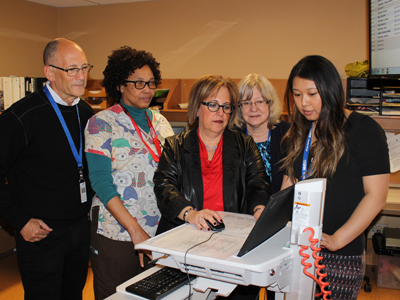What is SBAR?

"SBAR gives us a place to begin." (OT)
In order to develop better ways to improve effective teamwork and communication, and protect patients and families from inadvertent harm, the Toronto Rehabilitation Institute (Toronto Rehab) conducted two research studies that adapted, implemented and evaluated the SBAR tool for use in rehabilitation and complex continuing care (CCC). The SBAR method helps to structure team communication by prompting health care providers to clearly and succinctly articulate the Situation, Background, Assessment and Recommendation of an issue.
Why SBAR?
The
Situation is that communication failures continue to be one of the leading causes of inadvertent patient harm. At Toronto Rehab, a member of the University Health Network, a large academic rehabilitation and complex continuing care hospital, we have embarked on a number of patient safety strategies, one of which is to enhance effective interprofessional team communication. In a pilot study we adapted, implemented and evaluated SBAR (Situation-Background-Assessment-Recommendation), a structured communication tool for use on a rehabilitation setting, with promising results. Our subsequent work focused on the priority issue of communicating falls assessment, prevention and management on units with high falls incidence.
SBAR in the Context of Interprofessional Teams
The
Background is that the SBAR tool is a situational briefing model that provides appropriate assertion, critical language and education to a safety issue. While many healthcare organizations have implemented the SBAR tool, there is little evidence regarding its effectiveness beyond the acute care environment and nurse-physician communication. The aim of this website is to provide clinicians, leaders and educators with the resources they need to help implement the adapted SBAR tool into their interprofessional care settings.
SBAR Implementation Toolkit
Our
Assessment is that you may wish to download our SBAR Implementation Toolkit. In partnership with the
Canadian Patient Safety Institute, we have developed a toolkit that is designed for interprofessional teams. The toolkit contains suggested teaching guides and evaluation tools, as well as facilitated video scenarios. Click here for a free download of the
SBAR Implementation Toolkit (2nd ed).
SBAR Recommendations
We
Recommend that you use any of the tools offered here to help implement and evaluate the use of SBAR within your own organizations. You may also wish to refer to our published articles in this area.
The goal of our SBAR videos is to show SBAR in action and engage learners in a facilitated discussion about team communication. The videos highlight interprofessional team communication in two scenarios: during team rounds and between two clinicians (a physician and pharmacist) on a patient care unit. Each of these scenarios demonstrate both ineffective (Version A) and effective (Version B) team communication. The accompanying
Facilitator's Guide outlines the context, summary and key teaching points for facilitators to consider during SBAR education sessions.
Scenario 1: Team Rounds – Closing the loop
Scenario 2: Stuck in the 'hint and hope' model
Velji K, Baker GR, Fancott C, Andreoli A, Boaro N, Tardif G et al. 2008.
Effectiveness of an Adapted SBAR Communication Tool for a Rehabilitation Setting. Healthcare Quarterly 11(Special Issue): 72–79.
Boaro, N., C. Fancott, G.R. Baker, K. Velji and A. Andreoli. 2010. "Using SBAR to Improve Communication in Interprofessional Teams."
Journal of Interprofessional Care 24(10): 111–14.
Andreoli A, Fancott C, Velji, K, Baker GR, Solway S. et al. 2010.
Using SBAR to Communicate Falls Risk and Management in Interprofessional Rehabilitation Teams. Healthcare Quarterly 13 (Special Issue): 92-100.
Contact Us
For more information please contact:
Angie Andreoli, Project Manager, Quality and Safety
Phone: 416 597 3422 ext. 3984
Email: angie.andreoli@uhn.ca
Carol Fancott, Advanced Practice Leader, Patient Safety
Phone: 416 597 3422 ext. 3922
Email: carol.fancott@uhn.ca
